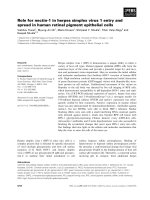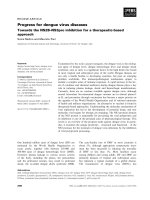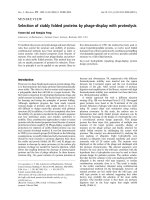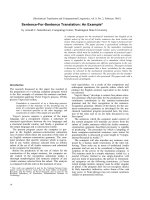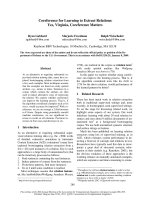báo cáo khoa học: "Selection for abdominal bristle number in Drosophila subobscura, a highly polymorphic species" ppsx
Bạn đang xem bản rút gọn của tài liệu. Xem và tải ngay bản đầy đủ của tài liệu tại đây (483.68 KB, 10 trang )
Selection
for
abdominal
bristle
number
in
Drosophila
subobscura,
a
highly
polymorphic
species
for
gene
arrangements
Maria-José
MARTINEZ-SEBASTIAN
J.L.
MENSUA
Departamento
de
Cenetica,
Facultad
de
Ciencias
Biol6gicas,
Avd.
Dr.
Moliner,
50,
Burjasot
(Valencia),
Spain
Summary
Two
replicate
selection
lines
for
abdominal
bristle
number
in
both
high
and
low
directions
and
2
control
lines
were
established
from
a
laboratory
population
of
Drosophila
subobscura
and
were
run
for
23-24
generations.
The
sum
of
the
bristles
on
the
4th
and
5th
abdominal
sternites
was
the
criterion
of
selection
and
the
intensity
of
selection
used
was
20
p.
100.
Response
to
selection
was
very
similar
to
the
response
obtained
by
other
authors
in
Drosophila
melanogaster.
This
indicates
that
the
behaviour
of
the
genotype
responsible
for
the
abdominal
bristle
number
may
be
similar
in
the
2
species,
in
spite
of
the
fact
that
Drosophila
subobscura
is
very
rich
in
chromosomal
polymorphisms
and
Drosophila
melanogaster
is
very
poor.
Key
words :
Artificial
selection,
neutral
trait,
Drosophila
subobscura.
Résumé
Sélection
pour
le
nombre
de
soies
abdominales
chez
Drosophila
subobscura,
espèce
très
polymorphe
pour
les
arrangements
géniques
On
a
établi
2
lignées
de
sélection
(haute
et
basse)
pour
le
nombre
de
soies
abdominales
ainsi
que
2
lignées
témoins
à
partir
d’une
population
de
laboratoire
de
Drosophila
subobscura.
On
a
conduit
la
sélection
pendant
23-24
générations.
Le
caractère
sélectionné
était
le
nombre
de
soies
des
4’
et
5’
sternites
de
l’abdomen
et
l’intensité
de
sélection
était
de 20
p.
100.
La
réponse
à
la
sélection
a
été
semblable
à
celle
obtenue
par
d’autres
auteurs
chez
Drosophila
melanogaster.
Cette
concordance
indique
que
la
nature
du
génotype
responsable
du
nombre
de
soies
abdominales
peut
être
similaire
dans
les
2
espèces,
bien
que
Drosophila
subobscura
montre
un
polymorphisme
chromosomique
beaucoup
plus
riche
que
Drosophila
melanogaster.
Mots
clés :
Sélection
artificielle,
caractère
neutre,
Drosophila
subobscura.
I.
Introduction
An
important
characteristic
of
Drosophila
subobscura
is
that
inversion
polymor-
phisms
are
found
on
all
of
its
major
chromosomes.
These
polymorphisms
have
not
only
been
studied
intensively
from
a
structural
and
a
evolutionary
point
of
view,
but
also
relative
to
other
characters
such
as
enzymatic
polymorphisms
and
morphological
traits
(see
an
update
review
by
K
RIMBAS
&
LoutcAS,
1980).
P
REVOSTI
(1967),
while
artificially
selecting
for
an
adaptative
trait,
wing
length,
in
Drosophila
subobscura,
found
a
stronger
response
than
that
obtained
in
Drosophila
melanogaster
by
other
workers
using
the
same
selection
criteria.
One
of
the
explana-
tions
given
for
this
was
that
the
numerous
inversions
in
D.
subobscura
facilitated
selection
response.
These
results
suggested
that
it
would
be
interesting
to
study
the
relationships
between
neutral
traits
and
chromosomal
polymorphisms,
and
specifically
to
determine
whether
the
presence
of
inversions
facilitates
selection
response
in
a
neutral
trait.
For
this
reason,
an
artificial
selection
experiment
for
abdominal
bristle
number
in
D.
subobscura
was
initiated.
Abdominal
bristle
number
is
classically
considered
to
be
a
neutral
character
(CLA
rroN et
al.,
1957 ;
LATTER
&
R
OBERTSON
,
1962)
and
has
been
used
in
a
large
number
of
artificial
selection
experiments
in
D.
melanogaster
(M
ATHER
&
H
ARRISON
,
1949 ;
R
ASMUSON
,
1955 ;
C
LAYTON
el
al.,
1957 ;
S
HELDON
,
1963 ;
F
RAN
-
KHAM
et
al. ,
1968 ;
Yoo,
1980).
The
response
to
selection for
this
neutral
trait
obtained
in
D.
subobscura,
a
species
with
high
level
of
inversion
polymorphisms,
was
then
compared
to
the
responses
reported
in
D.
melanogaster,
a
species
with
a
low
level
of
inversion
polymorphisms.
II.
Material
and
methods
A
sample
of
32
females
of
a
wild
population
of
D.
subobscura,
from
Ribarroja
(Valencia,
Spain),
was
used
to
start
the
population
used
in
this
experiment.
The
population
was
maintained
in
the
laboratory
for
5
months
before
the
experiment
began.
Before
selection
began,
the
heritability
of
abdominal
bristle
number
was
estimated
from
offspring-parent
regression
analysis.
Egg
samples
were
obtained
from
the
labora-
tory
population
and
placed
in
food
bottles
under
conditions
of
optimal
density.
Samples
of
males
and
females
were
taken
from
the
bottles
and
each
male
was
allowed
to
mate
in
a
separate
bottle
with
a
virgin
female.
When
the
progeny
emerged,
4
males
and
4
females
were
scored
for
each
of
150
couples
producing
offspring.
From
the
laboratory
population,
2
replicate
selection
lines
for
abdominal
bristle
number
in
both
high
(Hl
and
H2)
and
low
(Ll
and
L2)
directions
and
2
control
lines
(Cl
and
C2)
were
run
23-24
generations.
The
sum
of
the
bristles
on
the
4th
and
5th
sternites
was
the
criterion
used
in
selection
and
the
intensity
of
selection
was
20
p.
100.
Twenty
males
and
20
females
from
each
of
6
bottles
in
each
of
the
2
high
and
low
lines
were
scored
each
generation.
The
most
extreme
4
males
and
4
females
from
each
bottle
were
selected.
Therefore
in
each
line
240
individuals
were
scored
and
48
individuals
were
selected
for
breeding
each
generation.
In
each
of
the
control
lines
20
males
and
20
females
were
also
selected
and
scored
from
each
of
the
6
bottles.
Again
4
males
and
4
females
were
selected
for
breeding.
In
these
lines,
however,
the
selection
was
done
randomly.
The
48
flies
selected
from
each
of
the
6
lines
in
each
generation
were
left
for
24
hours
on
medium
(R
OBERTSON
,
1960)
and
afterwards
the
eggs
were
collected.
In
all
cases
100
eggs
were
placed
in
each
bottle
(125
ml)
to
prevent
overcrowding.
All
flies
developed
at
19 °C
and
standard
corn
meal
medium
supplemented
with
live
yeast
was
used.
III.
Results
The
means
and
coefficients
of
variation
of
the
character
distributions
in
the
females
from
the
wild
and
laboratory
populations
are
given
in
table
1.
The
mean
is
higher
and
the
coefficient
of
variability
lower
for
the
laboratory
population,
which
is
as
expected
since
a
natural
environment
is
less
homogeneous
than
one
in
the
laboratory.
The
heritability
estimate
of
the
laboratory
population
and
its
standard
error
were
0.40
±
0.05.
This
value
was
sufficiently
large
to
ensure
a
good
response
in
a
mass
selection
exercise.
Figure
1
shows
the
results
of
23-24
generations
of
selection
in
the
high,
low
and
control
lines.
The
total
increase
in
the
HI
and
H2
high
selection
lines
was
40
and
37
respectively.
In
both
lines,
the
response
was
greater
in
early
generations
as
compared
to
the
later
generations.
The
rate
of
response
in
the
2
replicate
lines
was
very
similar.
The
behaviour
of
low
selection
lines
was
very
similar
to
that
displayed
by
the
high
selection
lines,
but
the
response
was
much
slower
after
the
first
few
generations.
The
total
response
resulted
in
a
decrease
of
23
and
21
bristles
in
the
Ll
and
L2
lines
respectively.
The
response
was
slower
in
these
lines,
particularly
in
the
later
genera-
tions,
because
some
of
the
flies
had
already
attained
the
lower
limit
of
zero
bristles.
Also
in
later
generations
individuals
showing
gross
defects
in
the
sclerotization
of
the
abdomen
appeared,
which
disguised
the
true
effect
of
selection
(R
ASMUSON
,
1955 ;
C
LAYTON
et
al. ,
1957).
In
both
the
Cl
and
C2
control
lines
the
mean
bristle
number
tended
to
remain
somewhat
constant
but
with
a
slight
tendency
to
increase.
mean
of
35
bristles
in
the
laboratory
population
at
the
start
had
changed
to
a
mean
of
37
bristles
by
the
end
of
the
experiment.
Overall
the
response
to
the
selection
was
asymmetrical,
being
much
greater
when
selection
was
for
high
bristle
number.
This
asymmetry,
which
appears
in
the
first
generations,
seems
to
be
due
to
the
effect
of
scale
because
the
realized
heritability
was
the
same
in
the
high
and
low
selection
lines,
at
least
during
the
early
generations.
In
the
L2
line
heritability
dropped
to
zero
in
the
later
generations.
Sublines
were
taken
from
all
high
and
low
selection
lines
at
the
4th
generation
and
submitted
to
reverse
selection
for
6
generations.
These
sublines
were
developed
under
the
same
conditions
as
selection
lines.
In
all
reverse
selection
lines
(fig.
1)
the
mean
of
the
character
increased
or
decreased
and
reached
the
mean
value
of
the
control
lines
in
5
generations.
These
results
indicate
that
all
selected
lines
retained
a
high
level
of
variability
in
spite
the
changes
that
occurred
in
the
means
(F
RANKHAM
et
al. ,
1968).
At
the 4th
and
20th
generations
of
selection,
natural
selection
sublines
were
developed
from
each
high
and
low
selection
line
(fig.
1).
In
all
but
one
of
these
natural
selection
lines,
the
mean
remained
constant
and
did
not
show
any
tendency
to
revert
to
initial
values.
The
second
time
natural
selection
lines
were
developed,
the
line
from
L2
showed
a
different
behaviour.
As
can
be
seen
in
figure
1,
the
bristle
number
of
that
line
increased
and
its
coefficient
of
variation
decreased
markedly
(from
38
to
12).
In
all
directional
selection
lines
the
coefficient
of
variation
(fig.
2)
remained
more
or
less
constant
until
the
9th
generation.
After
that
the
high
and
low
selection
lines
began
to
show
different
behaviours.
In
both
the
control
and
high
selection
lines,
the
coefficient
of
variation
did
not
show
significant
changes
or
decreased
slightly.
In
the
low
selection
lines,
the
coefficient
of
variation
increased
significantly,
particularly
in
the
L2
line.
In
order
to
know
some
characteristics
of
the
genotypes
selected,
reciprocal
crosses
between
selection
lines
were
made
when
the
selection
process
had
been
completed
(tabl.
2).
In
each
cross
60
males
and
60
females
were
mated
and
120
individuals
of
each
sex
of
the
Fl and
F2
were
scored.
between
males
and
females
of
the
Fl
indicate
that
there
are
factors
on
the
X
chromosome.
In
addition
mean
values
of
males
and
females
of
the
F2
of
each
cross
increased
or
decreased
in
respect
to
the
F1
values
as
was
expected.
As
can
be
seen
in
table
2,
the
mean
value of
the
Fl
from
crosses
between
selected
lines
was
usually
smaller
than
the
average
of
the
parents.
The
explanation
for
this
may
be
that
the
genes
responsible
for
low
bristle
number
are
partially
dominant
over
the
genes
for
high
bristle
number.
Such
an
effect
has
been
found
by
F
RANKHAM
(1970).
C
LAYTON
et
1
1I.
(1957),
K
IDWELL
&
K
IDWELL
(1966)
and
R
ATHIE
&
NICHOLAS
(1980),
however,
found
complete
additivity
for
the
same
character.
The
sex-dimorphism
ratio
oscillated
between
1
and
1.02
in
the
laboratory
popula-
tion.
These
values
indicated
that
there
is
no
sex-dimorphism
with
respect
to
abdominal
bristle
number
in
D.
subobscura,
in
contrast
to
other
species
(Yoo
et
al.,
1981).
The
response
pattern
was
very
similar
between
sexes
within
a
line.
A
NCOVA
analysis
shows
significant
differences
between
sexes
only
in
the
L2
line
(F
=
4.3,
P
=
0.05).
Both
selected
and
control
lines
show
a
considerable
oscillation
in
viability,
but
the
regression
of
viability
on
generation
number
is
significant
only
in
a
few
cases.
These
regressions
are
negative
in
all
lines
except
Cl,
which
suggests
that
the
process
of
selection
leads
to
a
decrease
in
viability,
as
is
typical
in
artificial
selection
experiments.
IV.
Discussion
P
REVOSTI
(1967),
making
artificial
selection
for
wing
length
in
D.
subobscura,
found
a
response
stronger
than
the
response
obtained
by
other
workers
using
the
same
selection
criteria
in
D.
melanogaster.
One
of
the
explanations
given
for
this
was
that
there
were
numerous
inversions
present
in
the
populations
he
submitted
to
selection.
During
selection,
the
blocks of
genes
included
in
inversions
apparently
can
behave
as
« supergenes
» in
controlling
differences
in
wing
length.
So,
at
least
in
the
early
generations,
selection
is
concerned
with
only
a
few
units,
each
with
a
large
effect.
D.
melanogaster
does
not
have
numerous
inversions
on
the
chromosomes,
consequently
selection
acts
on
many
more
individual
units
(single
genes)
associated
with
polygenic
variation.
Thus
the
long-term
selection
effect
is
greater
but
the
short-term
selection
response
is
slower
(P
REVOSTI
,
1967).
In
the
present
experiment,
using
a
population
of
D.
subobscura
highly
polymorphic
for
numerous
inversions
(M
ARTINEZ
-S
EBASTIAN
&
DE
F
RUTOS
,
1983),
a
response
to
short-
term
selection
greater
than
the
response
obtained
in
D.
melanogaster,
and
a
lesser
response
to
long-term
selection,
would
be
expected.
Yet
by
comparing
the
results
with
previous
studies
on
D.
melanogaster
(C
LAYTON
et
al.,
1957 ;
CL
A
YTON
&
ROBERTS
ON
,
1957 ;
S
HELDON
,
1963 ;
FxANxHAM et
al.,
1968 ;
etc.)
it
can
be
seen
that
the
response
is
very
similar
in
the
2
species.
C
LAYTON
et
al.
(1957),
using
the
same
intensity
of
selection
(20
p.
100),
obtained
a
response
of
2.6
bristles
per
generation
in
high
selection
lines
and
1.5
bristles
in
low
selection
lines,
during
the
first
five
generations.
In
the
present
experiment
a
very
similar
response
was
observed
(2.5
and
1.6
respectively)
in
the
first
five
generations.
Considering
the
entire
24
generations
of
selection,
the
response
in
the
2
species
was
remarkably
similar.
The
response
of
natural
selection
sublines
indicates
that
the
forces
regulating
the
maintenance
of
bristle
number
are
not
very
strong
and
that
the
factors
determining
bristle
number
are
really
neutral
for
natural
selection
(FALCONER,
1981)
in
much
the
same
way
as
in
Drosophila
melanogaster
abdominal
bristle
number
and
other
bristle
systems
(C
LAY
TON et
Cil. ,
1957 ;
LATTER
&
ROBERT
SO
N,
1962 ;
CREUS,
1978 ;
MARCOS
&
C
REUS
,
1981).
The
variability
in
selection
lines
is
shown
in
figure
2.
Variability
did
not
decrease
in
one
control
line.
But
somewhat
surprisingly
it
did
not
decrease,
as
might
be
expected,
in
all
the
selection
lines.
This,
however,
has
also
been
found
in
other
selection
experiments
and
may
be
due
to
the
release
of
new
genetic
variability
through
recombination
(M
ATHER
,
1941 ;
T
HODAY
&
B
OAM
,
1961 ;
T
HODAY
et
al. ,
1964 ;
I
NGRAM
&
JINKS,
1982)
or
due
to
the
increase
of
developmental
errors
arising
from
an
increased
level
of
homozygosity
(REEVE
&
R
OBERTSON
,
1953 ;
FALCONER,
1955).
The
sudden
and
spectacular
increase
in
the
coefficient
of
variation
which
occurred
in
the
L2
line
might
be
due
to
selection
of
heterozygotes
for
genes
which
are
lethal
in
one
of
the
homozygous
combinations
but
which
have
some
effect
on
bristle
number
in
the
heterozygous
combination
(C
LAYTON
et
al. ,
1957 ;
F
RANKHAM
et
al. ,
1968 ;
F
RANKHAM
,
1970 ;
Yoo,
1980).
This
agrees
with
the
fact
that
this
line
(L2)
is
the
only
one
that
reaches
a
plateau
while
a
high
level
of
phenotypic
variability
still
remains.
Moreover,
when
the
second
set
of
natural
selection
sublines
were
developed
the
response
of
the
L2
natural
selection
line
supports
the
idea
that
heterozygotes
for
a
lethal
gene
have
increased
in
frequency.
M
ATHER
(1941)
observed
enormous
variation
in
abdominal
bristle
number,
particu-
larly
in
the
ratio
of
number
in
the
2
sexes,
among
several
species
of
Drosophila.
The
values
of
the
sex-dimorphism
ratio
in
our
laboratory
population
and
the
fact
that
the
response
pattern
in
the
selection
lines
was
very
similar
between
sexes
within
a
line
indicate
that
there
is
no
sex-dimorphism
in
D.
subobscura,
in
contrast
to
other
species
(Yoo
et
al.,
1981).
Crosses
between
lines
show
the
existence
of
factors
influencing
bristle
number
in
chromosome
X.
Consequently,
the
lack
of
sex-dimorphism
in
this
species
must
be
due
to
total
dosage
compensation
for
the
number
of
abdominal
bristles.
The
high
degree
of
agreement
between
the
response
to
selection
in
D.
melanogas-
ter
and
D.
subobscura
indicates
that
the
behaviour
of
the
genes
responsible
for
the
abdominal
bristle
number
must
be
similar
in
the
2
species,
in
spite
of
the
fact
that
D.
subobscura
is
very
rich
in
chromosomal
polymorphisms
and
D.
melanogaster
is
very
poor.
Why,
when
selection
is
for
wing
length,
does
the
presence
of
inversions
provoke
a
stronger
response
than
the
expected
(P
REVOST
i,
1967)
whereas,
when
selection
is
for
abdominal
bristle
number,
the
presence
of
inversions
seems
to
have
no
effect
on
response ?
The
answer
to
this
question
may
be
in
the
differences
between
the
2
traits.
A
study
by
P
REVOST
t
(1967)
gives
evidence
that
the existence
of
differences
in
the
genes
controlling
wing
size,
within the
inverted
regions
of
chromosomes,
was
responsi-
ble
for
the
rapid
selection
response.
He
suggested
that
the
selection
process
involves
only
a
few
units
(blocks
of
genes)
rather
than
individual
polygenes.
For
a
neutral
character,
such
as
abdominal
bristle
number,
it
is
reasonable
that
some
of
the
chromosomal
arrangements
may
each
have
some
genes
with
a
positive
effect
and
some
with
a
negative
effect.
That
is
to
say,
the
different
arrangements
of
each
chromosome
may
have
the
same
overall
effect
on
the
character.
A
similar
effect
has
been
found
in
numerous
cases
with
enzymatic
polymorphisms
(Z
OUROS
et
al. ,
1974 ;
L
OUKAS
&
K
RIMBAS
,
19
g
0 ;
C
ABRERA
et
al.,
1983).
If
this
is
true,
selection
will
tend
to
cause
structural
homozygosity
(M
ARTINEZ
-
S
EBASTIAN
&
DE
F
RUTOS
,
in
preparation)
but
the
response
in
the
early
generations
will
not
be
stronger
than
would
occur
if
the
genes
influencing
the
trait
were
only
partially
linked.
When
the
level
of
structural
homozygosity
increases,
the
suppression
of
recom-
bination
due
to
the
presence
of
inversions
will
disappear
(KmMBns
&
ZouRos,
1969 ;
S
PERLICH
&
F
EUERBACH
,
1974).
If
recombination
is
then
allowed,
the
response
to
selection
will
continue
(R
ASMUSO
rr,
1955 ;
C
ARSON
,
1958 ;
MCP
HEE
&
R
OBERTSON
,
1970 ;
M
ARKOW
,
1975)
and
the
total
response
to
long-term
selection
will
be
similar
to
the
response
obtained
in
a
less
polymorphic
species
such
as
D.
melanogaster.
Received
October
21,
1985.
.
Accepted
April
18,
1986.
Acknowledgements
We
would
like
to
thank
Dr.
de
FR
uTos
for
her
valuable
advice
and
criticism
of
this
paper
and
Dr.
T
HELEN
for
criticizing
the
paper
and
correcting
the
English
text.
References
C
ABRERA
V.M.,
G
ONZALEZ
A.M.,
L
ARRUGA
J.M.,
V
EGA
C.,
1983.
Linkage
diseqbilibrium
in
chromosome
A
of
Drosophila
subobscura.
Genetica,
61,
3-8.
C
ARSON
H.L.,
1958.
Response
to
selection
under
different
conditions
of
recombination
in
Droso-
phila.
Cold
Spring
Harbor
Symp.
Quant.
Biol.,
23,
219-306.
C
LAYTON
G.A.,
MORRIS
J.A.,
R
OBERTSON
A.,
1957.
An
experimental
check
on
quantitative
genetical
theory.
I.
Short-term
response
to
selection.
J.
Genet.,
55,
131-151.
C
LAYTON
G.A.,
R
OBERTSON
A.,
1957.
An
experimental
check
on
quantitative
genetical
theory.
II.
The
long-term
effects
of
selection.
J.
Genet.,
55,
152-170.
C
REUS
A.,
1978.
Contribuci6n
al
estudio
de
algunos
caracteres
cuantitativos
de
Drosophila
melanogaster
y
de
su
relacion
con
la
eficacia
biol6gica,
374
pp.,
Tesis
Doctoral,
Universidad
de
Barcelona.
FALCONER
D.S.,
1955.
Patterns
of
response
in
selection
experiments
with
mice.
Cold
Spring
Harbor
Symp.
Quant.
Biol.,
20,
178-196.
FALCONER
D.S.,
1981.
Introduction
to
Quantitative
Genetics.
340
pp.,
Longman,
London.
F
RANKHAM
R.,
1970.
The
effects
of
different
chromosomes
on
four
bristle
number
characters
of
Drosophila
melanogaster.
Aust.
J.
Biol.
Sci.,
23,
503-505.
F
RANKHAM
R.,
J
ONES
L.P.,
BARKER
J.S.F.,
1968.
The
effects
of
population
size
and
selection
intensity
in
selection
for
a
quantitative
character
in
Drosophila.
I.
Short-term
response
to
selection.
Genet.
Res.,
12,
237-248.
I
NGRAM
N.R.,
JINKS
J.L.,
1982.
Analysis
of
induced
quantitative
variation.
II.
The
recombinant
inbred
lines.
Heredity,
48,
79-84.
K
IDWELL
J.F.,
K
IDWELL
M.M.,
1966.
The
effects
of
inbreeding
on
body
weight
and
abdominal
chaeta
number
in
Drosophila
melanogaster.
Canad.
J.
Genet.
Cytol.,
8,
207-215.
K
RIMBAS
C.B.,
ZoUROS
E.,
1969.
Crossing
over
suppression
between
linked
but
non
overlapping
inversions
in
D.
subobscura.
Dros.
Inf.
Serv.,
44,
71-72.
K
RIMBAS
C.B.,
L
OUKAS
M.,
1980.
The
inversion
polymorphism
of
Drosophila
subobscura.
Evol.
Biol.,
12,
163-234.
LATTER
B.D.H.,
R
OBERTSON
A.,
1962.
The
effects
of
inbreeding
and
artificial
selection
on
reproductive
fitness.
Genet.
Res.,
3,
110-138.
L
OUKAS
M.,
K
RIMBAS
C.B.,
1980.
The
genetics
of
Drosophila
subobscura
populations.
XVI.
Heterokaryosis
and
heterozygosity.
Genetica,
54,
69-74.
M
AR
cos
A.,
C
REUS
R.,
1981.
Interocellar
bristles
in
Drosophila
melanogaster.
II.
Response
to
long-term
selection.
Genet.
Pol.,
22,
103-111.
M
ARKOW
T.A.,
1975.
A
genetic
analysis
of
phototactic
behaviour
in
Drosophila
melanogaster.
I.
Selection
in
the
presence
of
inversions.
Genetics,
79,
527-534.
M
ARTINEZ
-S
EBA
S
TIAN
M.J.,
DE
FR
uTos
R.,
1983.
Chromosomal
polymorphism
in
Drosophila
subobscura
populations
submitted
to
selection
for
a
quantitative
character.
Dros.
Inf.
Serv.,
59,
79-80.
M
ATHER
K.,
1941.
Variation
and
selection
of
polygenic
characters.
J.
Genet.,
41,
159-193.
M
ATHER
K.,
H
ARRISON
B.J.,
1949.
The
manifold
effects
of
selection.
I
and
II.
Heredity,
3,
1-52
and
131-162.
MCP
HEE
C.P.,
R
OBERTSON
A.,
1970.
The
effect
of
suppressing
crossing-over
on
the
response
to
selection
in
Drosophila
melanogaster.
Genet.
Res.,
16,
1-6.
P
REVOSTI
A.,
1967.
Inversion
heterozygosity
and
selection
for
wing
length
in
Drosophila
subobs-
cura.
Genet.
Res.,
10,
81-93.
R
ASMUSON
M.,
1955.
Selection
for
bristle
numbers
in
some
unrelated
strains
of
Drosophila
melanogaster.
Acta
Zool.
Stockh.,
36,
1-49.
R
ATHIE
K.A.,
NICHOLAS
F.W.,
1980.
Artificial
selection
with
differing
population
structures.
Genet.
Res.,
36,
117-132.
REEVE
E.C.R.,
R
OBERTSON
F.W.,
1953.
Studies
in
quantitative
inheritance.
II.
Analysis
of
a
strain
of
Drosophila
melanogaster
selected
for
long
wings.
J.
Genet.,
51,
276-316.
R
OBERTSON
F.W.,
1960.
The
ecological
genetics
of
growth
in
Drosophila.
I.
Body
size
and
development
time
on
different
diets.
Genet.
Res.,
1,
288-340.
S
HELDON
B.L.,
1963.
Studies
in
artificial
selection
of
quantitative
characters.
I.
Selection
for
abdominal
bristles
in
Drosophila
melanogaster.
Aust.
J.
Biol.
Sci.,
16,
490-515.
S
PERLICH
D.,
F
EUERBACH
H.,
1974.
Epistatic
gene
interaction
crossing
over
and
linked
and
unlinked
inversions
in
Drosophila
subobscura.
Evolution,
28,
67-75.
T
HODAY
J.M.,
B
OAM
T.B.,
1961.
Regular
responses
to
selection.
I.
Description
of
responses.
Genet.
Res.,
2,
161-176.
T
HODAY
J.M.,
G
IBSON
J.B.,
S
PICKE
TT
S.G.,
1964.
Regular
responses
to
selection.
II.
Recombina-
tion
and
accelerated
response.
Genet.
Res.,
5,
1-19.
Yoo
B.H.,
1980.
Long-term
selection
for
a
quantitative
character
in
large
replicate
populations
of
Drosophila
melanogaster.
I.
Response
to
selection.
Genet.
Res.,
35,
1-17.
Yoo
B.H.,
MOTH
J.J.,
BAKER
J.S.F.,
1981.
Abdominal
bristle
numbers
and
sex-dimorphism
ratios
in
different
Drosophila
species.
Dros.
lnf.
Serv.,
56,
163-164.
ZouRos
E.,
K
RIMBAS
C.B.,
T
SAKAS
S.,
LouK
As
M.,
1974.
Genetic
versus
chromosomal
variation
in
natural
populations
of
Drosophila
subobscura.
Genetics,
78,
1223-1244.

